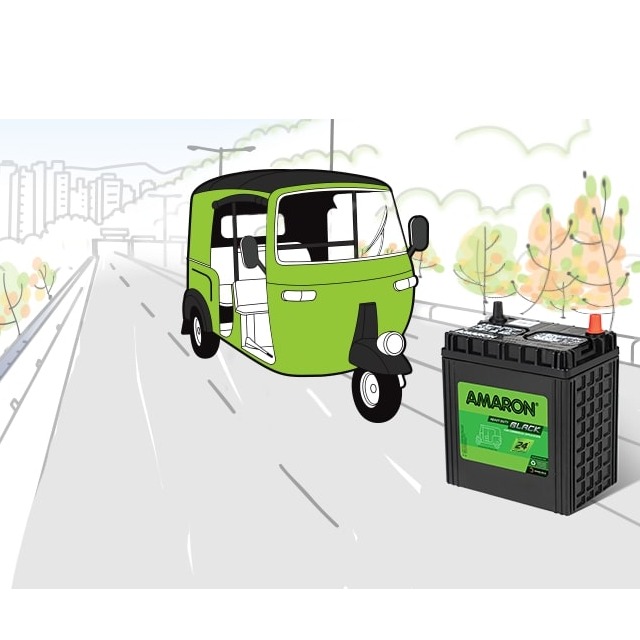Amaron Three Wheeler Batteries three-wheeler batteries, particularly for electric or hybrid models, it's essential to consider several key aspects, including types, specifications, applications, and maintenance. Here’s a detailed overview: Types of Batteries Lead-Acid Batteries: Flooded Lead-Acid: Common in many older models; require regular maintenance. AGM (Absorbent Glass Mat): Sealed, maintenance-free, and better suited for deep cycling. Gel Batteries: Similar to AGM, with electrolyte in gel form; resistant to vibration. Lithium-Ion Batteries: Higher energy density, longer life, and lighter weight compared to lead-acid. Require specific charging systems and management. Nickel-Metal Hydride (NiMH): Less common but used in some hybrid three-wheelers. Specifications Voltage: Common configurations include 12V, 24V, or 48V systems, depending on the vehicle's design. Capacity: Measured in amp-hours (Ah). Typical capacities range from 40Ah to 200Ah for three-wheelers. Dimensions: Vary widely based on battery type and configuration, usually fitting the vehicle's designated battery compartment. Weight: Lead-acid batteries are heavier than lithium-ion; weight can range from 20 kg to over 60 kg. Features Cycle Life: Indicates how many complete discharge and recharge cycles the battery can endure. Lead-acid batteries typically last 500-1000 cycles, while lithium-ion can last 2000-5000 cycles. Charging Time: Varies based on battery type; lead-acid typically takes 6-8 hours, while lithium-ion can recharge in 1-3 hours. Temperature Range: Most batteries operate effectively between 0°C and 40°C, but lithium-ion can perform better in extreme temperatures. Applications Urban Transportation: Commonly used in electric auto-rickshaws, delivery vehicles, and public transportation. Cargo Transport: Suitable for transporting goods in urban areas due to their maneuverability. Recreational Use: Some three-wheelers are used for leisure activities, requiring efficient power sources. Maintenance Lead-Acid Batteries: Regularly check electrolyte levels, clean terminals, and ensure proper charging. Lithium-Ion Batteries: Minimal maintenance; however, it’s important to avoid deep discharges and extreme temperatures. Monitoring: Use of battery management systems (BMS) is crucial for lithium-ion to optimize performance and longevity. Safety Considerations Ventilation: Ensure adequate ventilation for lead-acid batteries to prevent gas buildup. Charging Equipment: Use manufacturer-recommended chargers to avoid damage and ensure safety. Warranty and Lifespan Warranty: Typically ranges from 1 to 5 years, depending on the type and manufacturer. Lifespan: Varies by battery type; lead-acid may last 3-5 years, while lithium-ion can last 8-10 years with proper care.
Chat with us on WhatsApp
×
This is your website preview.
Currently it only shows your basic business info. Start adding relevant business details such as description, images and products or services to gain your customers attention by using Boost 360 android app / iOS App / web portal.

2024-09-27T05:32:32
Amaron Three Wheeler Batteries three-wheeler batteries, particularly for electric or hybrid models, it's essential to consider several key aspects, including types, specifications, applications, and maintenance. Here’s a detailed overview: Types of Batteries Lead-Acid Batteries: Flooded Lead-Acid: Common in many older models; require regular maintenance. AGM (Absorbent Glass Mat): Sealed, maintenance-free, and better suited for deep cycling. Gel Batteries: Similar to AGM, with electrolyte in gel form; resistant to vibration. Lithium-Ion Batteries: Higher energy density, longer life, and lighter weight compared to lead-acid. Require specific charging systems and management. Nickel-Metal Hydride (NiMH): Less common but used in some hybrid three-wheelers. Specifications Voltage: Common configurations include 12V, 24V, or 48V systems, depending on the vehicle's design. Capacity: Measured in amp-hours (Ah). Typical capacities range from 40Ah to 200Ah for three-wheelers. Dimensions: Vary widely based on battery type and configuration, usually fitting the vehicle's designated battery compartment. Weight: Lead-acid batteries are heavier than lithium-ion; weight can range from 20 kg to over 60 kg. Features Cycle Life: Indicates how many complete discharge and recharge cycles the battery can endure. Lead-acid batteries typically last 500-1000 cycles, while lithium-ion can last 2000-5000 cycles. Charging Time: Varies based on battery type; lead-acid typically takes 6-8 hours, while lithium-ion can recharge in 1-3 hours. Temperature Range: Most batteries operate effectively between 0°C and 40°C, but lithium-ion can perform better in extreme temperatures. Applications Urban Transportation: Commonly used in electric auto-rickshaws, delivery vehicles, and public transportation. Cargo Transport: Suitable for transporting goods in urban areas due to their maneuverability. Recreational Use: Some three-wheelers are used for leisure activities, requiring efficient power sources. Maintenance Lead-Acid Batteries: Regularly check electrolyte levels, clean terminals, and ensure proper charging. Lithium-Ion Batteries: Minimal maintenance; however, it’s important to avoid deep discharges and extreme temperatures. Monitoring: Use of battery management systems (BMS) is crucial for lithium-ion to optimize performance and longevity. Safety Considerations Ventilation: Ensure adequate ventilation for lead-acid batteries to prevent gas buildup. Charging Equipment: Use manufacturer-recommended chargers to avoid damage and ensure safety. Warranty and Lifespan Warranty: Typically ranges from 1 to 5 years, depending on the type and manufacturer. Lifespan: Varies by battery type; lead-acid may last 3-5 years, while lithium-ion can last 8-10 years with proper care.
2024-09-27T05:32:32
Keywords
- 60 kg
- 20 kg
- gel form
- 1-3 hours
- 6-8 hours
- 8-10 years
- proper care
- gas buildup
- urban areas
- longer life
- 48V systems
- battery type
- 1 to 5 years
- deep cycling
- Gel Batteries
- Charging Time
- hybrid models
- lighter weight
- Most batteries
- deep discharges
- Cargo Transport
- 500-1000 cycles
- recharge cycles
- proper charging
- Recreational Use
- 2000-5000 cycles
- Lifespan Warranty
- Flooded Lead-Acid
- delivery vehicles
- Temperature Range
- detailed overview
- many older models
- electrolyte levels
- leisure activities
- Typical capacities
- Charging Equipment
- Minimal maintenance
- regular maintenance
- Lead-Acid Batteries
- battery compartment
- Features Cycle Life
- Absorbent Glass Mat
- several key aspects
- Urban Transportation
- extreme temperatures
- Nickel-Metal Hydride
- adequate ventilation
- Lithium-Ion Batteries
- hybrid three-wheelers
- public transportation
- Common configurations
- Higher energy density
- Specifications Voltage
- electric auto-rickshaws
- three-wheeler batteries
- Three Wheeler Batteries
- efficient power sources
- many complete discharge
- specific charging systems
- battery management systems
- manufacturer-recommended chargers
- Safety Considerations Ventilation

Submit Your Enquiry